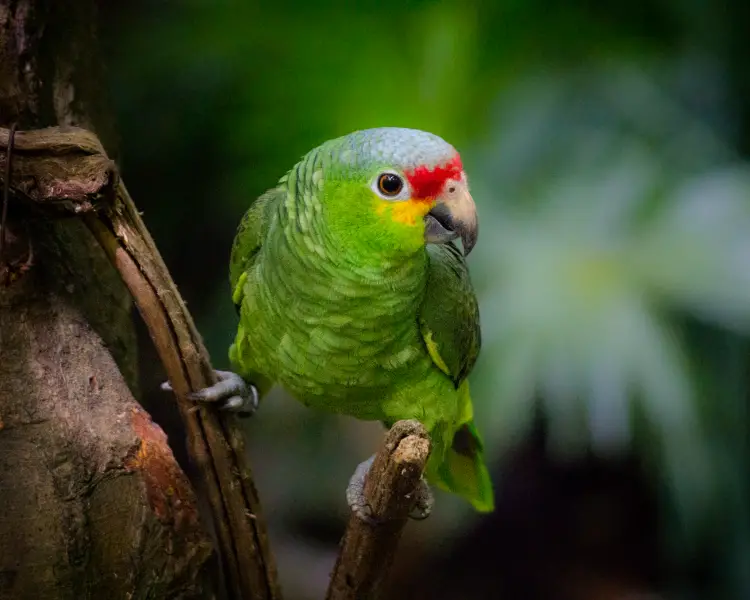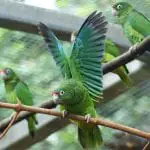Scientific Facts
| Common Name | Red-lored Amazon |
| Scientific Name | Amazona autumnalis |
| Lifespan | 75 – 80 Years |
| Size | 13.2 inches (34cm) |
| Body Mass | 11 – 17oz. (314 – 485grams) |
| Habitat | Semi-deciduous forest, evergreen forest, cultivated areas, mangroves |
| Range | Tropical regions of the Americas |
Information & Physical Appearance
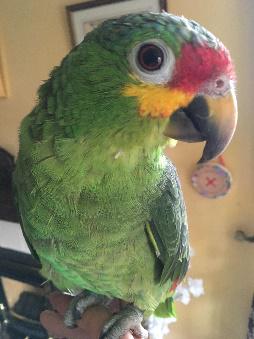
The Red-lored Amazon (Amazona autumnalis) is a member of the order Psittaciformes, the family Psittacidae, and the genus Amazona.
Other common names include Red-lored Parrot, Scarlet-lored Amazon, Scarlet-lored Parrot, Golden-cheeked Amazon, Golden-cheeked Parrot, Red-fronted Amazon, Red-fronted Parrot, Primrose-cheeked Amazon, Primrose-cheeked Parrot.
There are two races, including the nominate race.
1. A.a. autumnalis (nominate race).
There is no sexual dimorphism, and so both adults are identical in physical appearance.
The feathers are mostly green in general. However, the lores, as well as the head, display red coloring, and hence the name.
Also, there is black edging to the feathers covering the area that spans from the mantle and breast to the crown.
On top of the head, and on the back of the head, one can notice feathers tipped in lilac-blue.
The largest wing feathers are mostly yellow, and so are the upper cheeks.
The tail is square and green. It is tipped with blue and yellowish-green.
The bill’s coloration is grey, with a base of the upper mandible exhibiting yellow/horn coloration.
There is a red-colored, fleshy, often feathered projection above the upper bill.
The eye’s iris is orange, surrounded by a white eye ring. The neck is short, and the tail is large.
2. A.a. salvini (Salvin’s Amazon)
The female and male salvini adults are identical to autumnalis adults.
The major difference is that in salvini adults, the area that spans from the ear coverts to the upper cheeks exhibits yellow/green coloring, with less yellow, or no yellow at all.
Also, the eye ring is pale yellow instead of white, and the side tail feathers’ coloration is red at the very bases.
Juvenile
Juveniles are duller-colored than adults. The iris of the eye is brown instead of orange, and the red coloring on the lores and forehead is diminished.
Lifespan
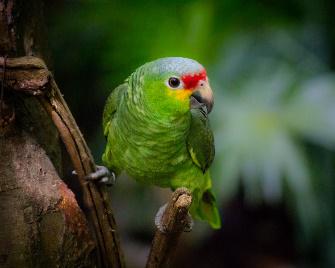
Red-lored amazons can live up to 75 – 80 years of age when given proper care.
The generation length is 12.3 years.
Ecosystem & Habitat
Red-lored Amazons are found in South, North, and Central America. Note that most Scarlet-lored Amazons are found in Panama.
RANGE
A.a. autumnalis’ range spans across from Honduras (including Bay Islands) to Mexico.
A.a salvini’ range extends throughout northwestern Venezuela, southwestern Colombia, and Honduras.
HABITAT
Red-lored Amazons are arboreal creatures known to live is a wide range of habitats, namely open areas characterized by trees, gallery forests, woodlands, wooded swamps, and mangroves.
Although they do inhabit cultivated areas (including plantations), these parrots prefer to live in wild areas and can be primarily found in rainforests.
Scarlet-lored Amazons mainly occur at elevations below 2624ft. (800 meters).
Food & Diet

Red-Lored Parrots are strictly vegetarian.
In the wild, they feed on a variety of nuts, fruits (including but not limited to oranges, figs, palm fruits, and mangoes), seeds, greens, berries, buds, and blossoms.
Coffee beans are also gladly taken.
By using their strong beaks, these parrots manage to crack nuts with impressive ease.
Usually, red-lored amazons eat up in the trees. During the course of feeding, they become unusually quiet.
Behavior
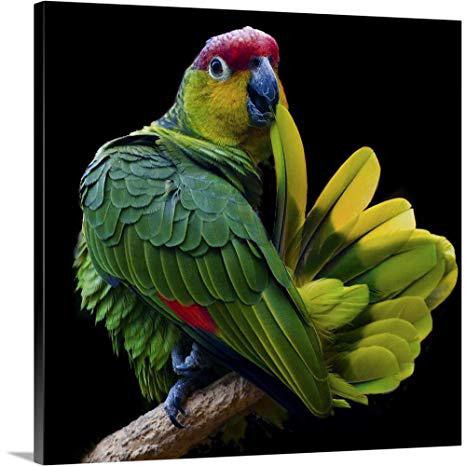
Although not migratory birds, red-lored amazons are nomadic.
It is in the winter when they move to open areas. During the breeding season, they live in rainforests.
These social creatures are found in pairs or in loose flocks.
At feeding sites, Scarlet-lored amazons are gregarious and can be often found with macaws.
Like other Amazona species, Red-lored parrots roost communally in tall trees in mangroves or gallery forest. There is a reported case of 800 red lores spotted together, sharing a communal roost site.
They move from nesting to roosting places on a daily basis. It is suggested that they mate for life.
Reproduction
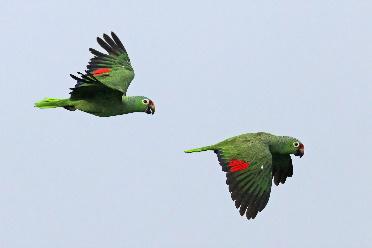
In Oaxaca, the breeding season takes place in April.
In Belize, it begins in February and continues throughout March.
In Ecuador, red lores breed from January to March, while in Belize, breeding begins in March and ends at some point in May.
In Panama, the breeding season is in the period February-May.
The breeding season in Colombia starts in January and proceeds throughout February.
Red lores found in Guatemala breed in March.
Nesting in hollow trees, these parrots typically lay 2 and up to 5 white, rounded eggs.
It takes 20 – 32 days for the eggs to hatch.
Hatchlings are born helpless, naked, and blind.
It is the female to feed and brood the young chicks during the first 10 days upon hatching. Later on, males help females in taking care of their offspring.
The young are ready to leave the nest in about 3 weeks. However, some individuals can stay with their parents up until the next breeding season.
Survival Threats & Conservation
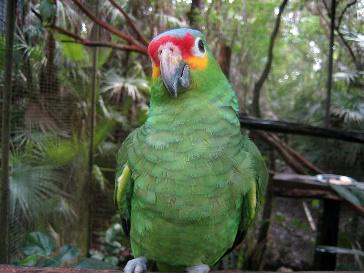
Red-lored parrots are listed on CITES’ Appendix II. Also, they are listed under the Least Concern category on the IUCN Red List.
Even though red lores are not considered seriously endangered with extinction as of now, they are on their way to becoming critically endangered.
The major survival threat is none other but the continuous destruction of habitat (deforestation).
Also, red lores are heavily hunted as a prized food source on a local and national level. Nonetheless, their colorful feathers keep being used in ceremonial dances.
Another serious threat is the high demand for these creatures as pets.
The population trend is decreasing.
As of 2019, there is no action recovery plan and no systematic monitoring scheme.
The best way to protect Red-lored Amazons from extinction is to maintain and preserve their natural habitat: the rainforest.
Availability – Where to Get a Red-lored Amazon
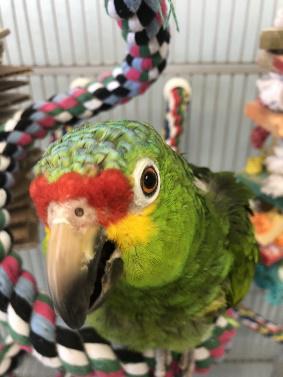
Red-lored amazons are fairly common in captivity, especially in the USA. However, the salvini race tends to be less common.
Red-lored amazons are available for sale from avian-specialty stores, as well as directly from breeders.
It is possible to adopt a red-lored amazon from rescue organizations, too.
Interesting Facts
- Apart from being “equipped” with powerful bills, red-lored parrots’ tongues are also especially powerful. It is by using both the tongue and the beak how they manage to husk seeds.
- Scarlet-lored amazons are believed to mate for life. It is often the case that they are seen flying in pairs. Apart from mating, the pairs are known to engage in cleaning each other’s feathers, as well as in partner feeding.
- Red lores’ calls are described as unmelodic, quite loud, and screeching. In fact, their calls are the strongest of all three Amazona species found in Panama! Unless when it comes to eating or resting, these parrots are often rather noisy.
- Red-lored amazons do not live in settled areas, so they do not really get in contact with humans frequently. In the few cases when they do get in contact with humans, it is because humans are hunting these amazing creatures. Ultimately, there is less damage done by these parrots to humans than the damage done on the parrot population by humans.
How to Care for the Red-lored Amazon
1. Housing & Enrichment
Provide a suspended cage or aviary of at least 9.8ft. (3 meters) in length.
Shallow water bowls and/or overhead misters are a must, as red lores enjoy bathing on a regular basis.
A variety of toys is crucial. Suitable toys include both destructible and non-destructible toys.
To keep these parrots happy and healthy, provide foot toys, food-finder toys, push-and-pull toys, and preening toys.
Utilize a variety of hanging perching toys of different sizes and texture. Also, utilize willow, fir, elder, and/or pine branches.
2. Diet
The base diet should be made up of commercial seed and pellet mixes.
Red lores adore oat seeds, sunflower seeds, and millet seeds.
Complete kibble is a must.
Supplement the daily diet with plenty of fresh nuts, berries, fruits, and green vegetables, as well as carrots, beans, celery, fresh corn, cooked pulses, and beans.
3. Personality
Red lores can be easily tamed. The earlier taming begins, the better.
They have the reputation of being very sociable. Also, they are regarded as some of the friendlier Amazona species one can keep as pets.
Apart from quickly adapting and bonding with people, they are very fun to watch and very playful.
Red lores are masters of becoming the center of attention, thanks to an array of silly tricks and goofs. Scarled-fronted Amazons do enjoy cuddling.
4. Speech and Sounds
Red-Lored Parrots’ ability to mimic human speech is often compared to African Grey Parrots.
Note that red lores can be quite noisy at times. The signal by using a loud caw.
They can develop a small vocabulary of words and repeat these words in a loud, clear voice.
Usually, the first things they learn and repeat include alarms, beeps, and laughing.
5. Possible Health Issues
Red-lored amazons are quite hardy creatures. To ensure red lore is to remain strong and healthy, providing a balanced diet is a must.
Also, it provides enough social interaction. Keep away from drafts. Make enough “parrots-proof” room for daily exercise outside the cage.
To avoid Vitamin-A deficiency, offer carrots, kale, and cooked sweet potato.
Ultimately, as long as the owners are to provide plenty of attention, good hygiene, and a lot of space for playing and exercise, there should be no serious issues with their red lore amazon pet.
FAQ Section
How Much Do Red-lored Amazons Cost?
Red-lored amazons are quite popular as pets in the Americas, and so they are easily available for sale. Red lores typically cost about $1000 – $2000.
Are Red-lored Amazons Good Pets?
Red-lored amazons are renowned for making good pets for the right owners, because of the ease of taming, as well as their playful, social, funny, devoted, cuddly personality.
Are Red-lored Amazons Good Talkers?
Yes, red-lored amazons are good talkers, although their talking abilities vary among individuals. Red lores can mimic human speech in a loud, clear manner, and are especially quick at learning and then repeating beeps, alarm sounds, and laughing.
Are Red-lored Amazons Loud?
Yes, red-lored amazons can be very loud, especially at certain times of the day. Whether they are trying to gain your attention or simply learning and repeating particular phrases, their voices are quite loud and clear.
How Long Do Red-lored Amazons Live?
The average lifespan of red-lored amazons is estimated at 75 years of age. However, when given proper care, they can live up to 80 years.
What Do Red-lored Amazons Eat?
Red-lored amazons eat nuts, berries, seeds, fruits, buds, and blossoms I the wild. In captivity, they thrive on a high-quality pelleted diet and limited seed mix, supplemented with daily servings of bird-safe fruits and vegetables.
What Foods Are Poisonous to Red-lored Parrots?
Certain foods can kill red-lored parrots. Do not feed a red-lored parrot with avocado, eggplants, chocolate, sugar or sugar-free candy, and avoid high-fat, high-sodium foods.
Do Red-lored Amazons Bite?
Like other Amazona species, red-lored amazons use their beaks for a variety of functions, including defense and play, among others. While they may sometimes attempt to bite, owners can quickly learn how to interpret their body language as to avoid getting bitten.
Are Red-lored Amazons Endangered with Extinction?
Red-lored amazons are not considered severely endangered with extinction. However, they are part of the IUCN Red List of Threatened Species under the Least Concern category.
Why Is the Red-lored Parrot Endangered?
The major survival threats to the red-lored parrot include habitat loss and heavy hunting/trapping. The population trend is decreasing, and the number of individuals left in the wild remains unknown as there is no systematic monitoring scheme.

